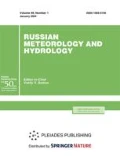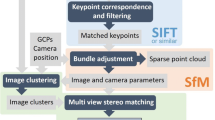Abstract
An algorithm for estimating the range of influence of broken cloudiness on the results of retrieving reflectance of cloudless Earth surface regions is proposed for satellite observations through gaps in a cloud field. The algorithm is based on the Monte Carlo method of simulation of radiation transfer in broken stochastic cloudiness with averaging over the cloud field. Two models of cloud fields are considered: the field shapes as parallelepipeds and paraboloids. The method is tested for two fragments of the real MODIS image with the coordinates of 53.4°–56.4° N, 109°–115° E and 49.0°–51.0° N, 121°–123° E. The results of computations show that the effect of cloudiness is significant at distances up to 25 km for the first image fragment and up to 5–7 km for the second one.




Similar content being viewed by others
REFERENCES
T. B. Zhuravleva, I. M. Nasrtdinov, and T. V. Russkova, “Influence of 3D Cloud Effects on Spatial-angular Characteristics of the Reflected Solar Radiation Field,” Optika Atmosfery i Okeana, No. 9, 29 (2016) [Atmos. Ocean. Opt., 30 (2017)].
V. E. Zuev and G. A. Titov, Modern Problems of Atmospheric Optics, Vol. 9: Atmospheric Optics and Climate (Spektr, Tomsk, 1996) [in Russian].
B. A. Kargin and S. M. Prigarin, “Imitational Simulation of Cumulus Clouds for Studying Solar Radiative Transfer in the Atmosphere by the Monte Carlo Method,” Optika Atmosfery i Okeana, No. 9, 7 (1994) [in Russian].
L. V. Katkovsky, “Parameterization of Outgoing Radiation for Quick Atmospheric Correction of Hyperspectral Images,” Optika Atmosfery i Okeana, No. 9, 29 (2016) [in Russian].
A. V. Kozhevnikova, M. V. Tarasenkov, and V. V. Belov, “Parallel Computations for Solving Problems of the Reconstruction of the Reflection Coefficient of the Earth’s Surface by Satellite Data,” Optika Atmosfery i Okeana, No. 2, 26 (2013) [Atmos. Ocean. Opt., No. 4, 26 (2013)].
S. A. Lysenko, “Atmospheric Correction of Multispectral Satellite Images Based on the Solar Radiation Transfer Approximation Model,” Optika Atmosfery i Okeana, No. 9, 30 (2017) [Atmos. Ocean. Opt., No. 1, 31 (2018)].
G. I. Marchuk, G. A. Mikhailov, M. A. Nazaraliev, R. A. Darbinyan, B. A. Kargin, and B. S. Elepov, Monte Carlo Method in Atmospheric Optics (Nauka, Novosibirsk, 1976) [in Russian].
S. M. Prigarin, T. B. Zhuravleva, and P. V. Volikova, “Poisson Model of Multilayer Broken Clouds,” Optika Atmosfery i Okeana, No. 10, 15 (2002) [in Russian].
M. V. Tarasenkov, A. V. Zimovaya, V. V. Belov, and M. V. Engel’, “Retrieval of Reflection Coefficients of the Earth’s Surface from MODIS Satellite Measurements Considering Radiation Polarization,” Optika Atmosfery i Okeana, No. 8, 32 (2019) [Atmos. Ocean. Opt., No. 2, 33 (2020)].
M. V. Tarasenkov, I. V. Kirnos, and V. V. Belov, “Observation of the Earth’s Surface from the Space through a Gap in a Cloud Field,” Optika Atmosfery i Okeana, No. 9, 29 (2016) [Atmos. Ocean. Opt., No. 1, 30 (2017)].
G. A. Titov, Statistical Description of Optical Radiation Transfer in Clouds, Doctor’s Thesis in Physics and Mathematics (IOA SO AN SSSR, Tomsk, 1988) [in Russian].
F. M. Breon and E. Vermote, “Correction of MODIS Surface Reflectance Time Series for BRDF Effects,” Remote Sens. Environ., 125 (2012).
M. Hess, P. Koepke, and I. Schult, “Optical Properties of Aerosols and Clouds: The Software Package OPAC,” Bull. Amer. Meteorol. Soc., No. 5, 79 (1998).
F. X. Kneizys, E. P. Shettle, G. P. Anderson, L. W. Abreu, J. H. Chetwynd, J. E. A. Selby, S. A. Clough, and W. O. Gallery, User Guide to LOWTRAN-7. ARGL-TR-86-0177. ERP 1010 (Hanscom AFB, MA 01731, 1988).
A. Lyapustin, J. Martonchik, Y. J. Wang, I. Laszlo, and S. Korkin, “Multiangle Implementation of Atmospheric Correction (MAIAC): 1. Radiative Transfer Basis and Look-up Tables,” J. Geophys. Res. Atmos., 116 (2011).
A. Marshak, A. Davis, W. Wiscombe, and R. Cahalan, “Radiative Smoothing in Fractal Clouds,” J. Geophys. Res. Atmos., No. D12, 100 (1995).
A. Marshak, K. F. Evans, T. Varnai, and G. Wen, “Extending 3D Near-cloud Corrections from Shorter to Longer Wavelengths,” J. Quant. Spectroscopy and Radiative Transfer, 147 (2014).
A. Marshak, G. Wen, J. A. Coakley Jr., L. A. Remer, N. G. Loeb, and R. F. Cahalan, “A Simple Model for the Cloud Adjacency Effect and the Apparent Bluing of Aerosols near Clouds,” J. Geophys. Res., 113 (2008).
O. V. Nikolaeva, L. P. Bass, T. A. Germogenova, A. A. Kokhanovsky, V. S. Kuznetsov, and B. Mayer, “The Influence of Neighbouring Clouds on the Clear Sky Reflectance Studied with the 3-D Transport Code RADUGA,” J. Quant. Spectroscopy and Radiative Transfer, No. 3–4, 94 (2005).
S. M. Prigarin, B. A. Kargin, and U. G. Oppel, “Random Fields of Broken Clouds and Their Associated Direct Solar Radiation, Scattered Transmission and Albedo,” Pure and Appl. Optics, 7 (1998).
G. A. Titov, T. B. Zhuravleva, and V. E. Zuev, “Mean Radiation Fluxes in the Near-IR Spectral Range: Algorithms for Calculation,” J. Geophys. Res. Atmos., No. D2, 102 (1997).
T. Varnai and A. Marshak, “MODIS Observations of Enhanced Clear Sky Reflectance near Clouds,” Geophys. Res. Lett., 36 (2009).
G. Wen, A. Marshak, R. F. Cahalan, L. A. Remer, and R. G. Kleidman, “3-D Aerosol-cloud Radiative Interaction Observed in Collocated MODIS and ASTER Images of Cumulus Cloud Fields,” J. Geophys. Res., 112 (2007).
Author information
Authors and Affiliations
Corresponding author
Additional information
Translated from Meteorologiya i Gidrologiya, 2021, No. 11, pp. 36-46. https://doi.org/10.52002/0130-2906-2021-11-36-46.
About this article
Cite this article
Tarasenkov, M.V., Zonov, M.N., Engel’, M.V. et al. Estimation of the Broken Cloud Effect on Retrieving Reflectance of Cloudless Earth Surface Regions from MODIS Imagery. Russ. Meteorol. Hydrol. 46, 747–754 (2021). https://doi.org/10.3103/S1068373921110030
Received:
Revised:
Accepted:
Published:
Issue Date:
DOI: https://doi.org/10.3103/S1068373921110030




